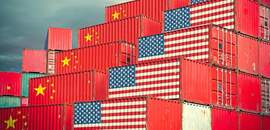Following unusual calm in 2017, market volatility has increased this year primarily for two reasons: (i) uncertainty about how high U.S. interest rates will rise; and (ii) increased trade tensions as the Trump administration seeks to fulfill campaign pledges about reducing the U.S. trade deficit via bilateral negotiations with key trading partners. The President’s announcement in March that the U.S. government intended to impose duties of 25% and 10%, respectively, on imports of steel and aluminum triggered a sell-off in global equity markets, as well as a vigorous response from trading partners. Meanwhile, the administration’s focus has shifted to China, which was long thought to be the principal target of U.S. sanctions: China runs the largest bilateral trade surplus with the U.S., and it is also the subject of complaints by U.S. businesses about unfair trading practices relating to technology transfer, intellectual property rights, and foreign investment in China. The administration is considering imposing duties on imported goods totaling $50 billion, and it has threatened to add another $100 billion to the list if China does not cooperate.
To head off a possible trade war, the two sides agreed to enter negotiations, and a delegation headed by Treasury Secretary Mnuchin flew to China in the first week of May. While officials from both sides put forth conciliatory messages to assuage markets, press reports suggest there is a wide gulf between them. The Economist magazine observed that “What, until now, has largely been a war of words could easily careen into a full-fledged trade war.”1 Martin Wolf of the Financial Times went even further in a column titled “Donald Trump declares trade war on China.”2
Notwithstanding these appraisals, financial markets have been calm. The reason: Investors believe the Trump administration is opening with an extreme position, so it can cut a better deal in the end. Meanwhile, investors have adopted a wait and see posture as a second round of negotiations gets underway.
My own take is a trade war is unlikely this year, especially with mid-term elections in November. It is not in China’s interest considering that access to the U.S. marketplace has been a key component of its development strategy, and its economy would feel the fallout from trade restrictions. As regards the U.S., President Trump is seeking to fulfill a campaign pledge but he also needs China’s support in brokering a deal with North Korea, which will require him to be flexible. A recent example is his willingness to assist a leading Chinese phone-maker, ZTE, avert bankruptcy after the Commerce Department imposed a seven year ban on U.S. companies from buying or selling its products.
Nonetheless, investors should not under-estimate the challenges in formulating a lasting trade agreement. Some of the U.S. demands are completely unacceptable to China: Notably, it should reduce its bilateral trade surplus ($370 billion in 2017) by $200 billion in the next two years, eliminate all “market-distorting subsidies” conducive to excess capacity, and agree not to retaliate against U.S. restrictions relating to intellectual property or investments from China in sensitive U.S. technology sectors or sectors critical to national security.
Accordingly, investors should be prepared for negotiations to continue for one-two years. While delay tactics are often a way to lessen the potential for conflict, the potential for conflict in this particular case actually increases over time. The reason: The U.S. budget deficit is expected to double to 5% of GDP in the next few years as a result of lost revenues embedded in the tax bill and increased government spending. A widening budget deficit, in turn, is likely to cause the U.S. trade imbalance to surge, as imports accelerate while exports lag.
This pattern is reminiscent of what occurred in the mid-1980s, when the U.S. first encountered a “twin deficit” problem while Japan ran a record current account surplus. The Reagan administration accused Japan of manipulating the yen to gain a competitive advantage, and it insisted that Japan institute “voluntary” restraints on auto exports to the U.S. While the Japanese government ultimately complied, U.S. bond yields surged and the dollar plummeted, as Japanese buying of U.S. bonds diminished.
History probably will not repeat this time, mainly because China will be less compliant to U.S. demands. Whereas the U.S. government views the current dispute as a way to level the playing field and restore lost jobs in manufacturing, China views it as an attempt to block the government’s initiative to upgrade its industry by deploying advanced technology. This was evident at a conference in Shanghai earlier this month, when several business attendees asked, “Why is the United States seeking to block China’s development into the realm of technology?” With the Chinese people viewing their country’s very future at stake in the negotiations, President Trump may learn how hard it is to win a trade war with China.
MarketWatch shares Nick Sargen's opinion in an article published on May 21st.
1 “Trade talks expose a chasm between China and America,” May 5, 2018.
2 Financial Times, May 5, 2018.



















